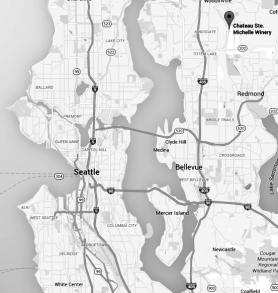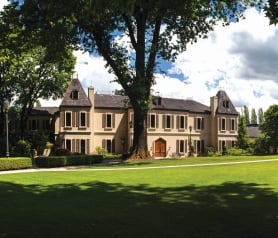Washington makes some of the finest wines you’ve probably never tasted — the state that is, not Washington, D.C.
You might wonder how they can grow quality wine grapes out there when last year the city of Seattle’s annual rainfall measured just shy of 120 centimetres. While there are urban wineries in South Seattle – 10 of them – the other 880-odd facilities are located in 12 AVAs (American Viticultural Areas) on the eastern side of the Cascade Mountains. Here, in desert conditions, they’re lucky if they even get 20 centimetres of rainfall a year, so growers have to rely on water from the Columbia River and its tributaries to irrigate their vines. These barren, windswept AVAs rejoice in some of the most poetic of names – Horse Heaven Hills, Rattlesnake Hills, Red Mountain, Walla Walla Valley …
In Washington, the names of the best vineyards are celebrated as much as, if not more than, the wineries that press and ferment their fruit. If your wine has grapes coming from any of these vineyards – Bacchus, Champoux, Ciel du Cheval, DuBrul, Klipsun, Sagemoor, Two Blondes or Weinbau – you’re in for a treat.
What makes these vineyards and those around them so special are the geological formations created by the Missoula Flood (so important they spell it with a capital F). The way Bob Betz, of Betz Family Winery in Redmond, explained it to me, the flood sounded like the scenario for a movie depicting the end of civilization: “The Missoula Flood is a tale of fire and ice, earthquakes and winds, tectonic plate shifts, mountains created by volcanic eruptions and floods that occurred during the last Ice Age.”
At 50,000-plus acres, the vineyard surface of all Washington’s AVAs is a little larger than Napa Valley. After California, the region represents the second-largest premium wine-producing area in the United States. One other statistic that the Charles Smith Winery (one of the South Seattle urban facilities) is proud of is that their Kung Fu Girl Riesling is the largest production from a single vineyard: 230,000 cases. Total wine production for the state is approximately 16 million cases, divided almost evenly between white and red.)
 The largest Washington winery is Chateau Ste. Michelle, founded in 1912 and headquartered in an elegant château in Woodinville. Under their own label they produce three million cases of white wine and a million red. As a group, Chateau Ste. Michelle and the wineries it owns produce eight million cases in total. They also host the annual Riesling Rendezvous, which “brings together leading experts and producers to explore the versatility of Rieslings from around the world, discuss issues and opportunities surrounding the advancement of Riesling, and forge alliances among producers and Riesling enthusiasts.” According to Bob Betz, “Chateau Ste. Michelle are the trailblazers who opened up markets for the rest of us.”
The largest Washington winery is Chateau Ste. Michelle, founded in 1912 and headquartered in an elegant château in Woodinville. Under their own label they produce three million cases of white wine and a million red. As a group, Chateau Ste. Michelle and the wineries it owns produce eight million cases in total. They also host the annual Riesling Rendezvous, which “brings together leading experts and producers to explore the versatility of Rieslings from around the world, discuss issues and opportunities surrounding the advancement of Riesling, and forge alliances among producers and Riesling enthusiasts.” According to Bob Betz, “Chateau Ste. Michelle are the trailblazers who opened up markets for the rest of us.”
Within spitting distance of the magnificent estate is what looks like an industrial plaza where you’ll find fifteen garagistes making wine in units of 1,500 square feet — wineries such as Pomum and Two Vintners. Bob Betz Family Winery started in one such unit; and so too did DeLille Cellars.
I spent a week earlier this year touring the AVAs and sampling wines at Taste Washington in Seattle, where some 230 wineries were pouring their products. I came to understand how the ripeness of the fruit and the diversity of their terroirs joined to produce these excellent wines.
A great new wine region will always attract the attention of traditional European winemakers — at least those who are not above rubbing shoulders with the rabble of the New World. Marchese Piero Antinori, whose family in Tuscany has been in the wine business for 26 generations, teamed up with Chateau Ste. Michelle to create Col Solare. Their ultra-modern winery is on Antinori Road, Benton City, in the Red Mountain AVA. Although the resident oenologist’s name is Darel Allwine, they make only red wine here — a Bordeaux-style Cabernet Sauvignon blend and a second wine called Shining Hill, a direct translation of Col Solare.
Meanwhile, a 26-minute ferry ride from Seattle to Vashon Island, the largest in Puget sound, will lead you to Andrew Will, one of the most renowned Washington wineries. Here, Chris Camarda crafts some of the finest red wines made in Washington, sourced from those glamorous vineyards, Champoux, Ciel du Cheval and Two Blondes.
My first introduction to the wind that blows through Horse Heaven Hills was on the roof of an estate called Alexandria Nicole Cellar Destiny Ridge Vineyard, located on 327 acres overlooking the Columbia River. Perched castle-like on top of a hill, the house commands a view of the entire appellation, overlooking a series of “Tiny Houses” that wine tourists can rent to be up close and personal with the vines. Or, if they choose, they can stay even more luxuriously in the main house.
While Washington first made its name with Riesling and Merlot (think Leonetti, Q uilceda Creek and Woodward Canyon) Cabernet Sauvignon and blends made from this grape will be the future of the region, I believe. Add to this Syrah and you have a portfolio of reds that speak to the unique soils of Washington with the ability to stand alongside any wines from California, Australia or even France.
Tony Aspler is the author of 17 books on wine, including his latest, Canadian Wineries.
You might wonder how they can grow quality wine grapes out there when last year the city of Seattle’s annual rainfall measured just shy of 120 centimetres. While there are urban wineries in South Seattle – 10 of them – the other 880-odd facilities are located in 12 AVAs (American Viticultural Areas) on the eastern side of the Cascade Mountains. Here, in desert conditions, they’re lucky if they even get 20 centimetres of rainfall a year, so growers have to rely on water from the Columbia River and its tributaries to irrigate their vines. These barren, windswept AVAs rejoice in some of the most poetic of names – Horse Heaven Hills, Rattlesnake Hills, Red Mountain, Walla Walla Valley …
In Washington, the names of the best vineyards are celebrated as much as, if not more than, the wineries that press and ferment their fruit. If your wine has grapes coming from any of these vineyards – Bacchus, Champoux, Ciel du Cheval, DuBrul, Klipsun, Sagemoor, Two Blondes or Weinbau – you’re in for a treat.
What makes these vineyards and those around them so special are the geological formations created by the Missoula Flood (so important they spell it with a capital F). The way Bob Betz, of Betz Family Winery in Redmond, explained it to me, the flood sounded like the scenario for a movie depicting the end of civilization: “The Missoula Flood is a tale of fire and ice, earthquakes and winds, tectonic plate shifts, mountains created by volcanic eruptions and floods that occurred during the last Ice Age.”
At 50,000-plus acres, the vineyard surface of all Washington’s AVAs is a little larger than Napa Valley. After California, the region represents the second-largest premium wine-producing area in the United States. One other statistic that the Charles Smith Winery (one of the South Seattle urban facilities) is proud of is that their Kung Fu Girl Riesling is the largest production from a single vineyard: 230,000 cases. Total wine production for the state is approximately 16 million cases, divided almost evenly between white and red.)
 The largest Washington winery is Chateau Ste. Michelle, founded in 1912 and headquartered in an elegant château in Woodinville. Under their own label they produce three million cases of white wine and a million red. As a group, Chateau Ste. Michelle and the wineries it owns produce eight million cases in total. They also host the annual Riesling Rendezvous, which “brings together leading experts and producers to explore the versatility of Rieslings from around the world, discuss issues and opportunities surrounding the advancement of Riesling, and forge alliances among producers and Riesling enthusiasts.” According to Bob Betz, “Chateau Ste. Michelle are the trailblazers who opened up markets for the rest of us.”
The largest Washington winery is Chateau Ste. Michelle, founded in 1912 and headquartered in an elegant château in Woodinville. Under their own label they produce three million cases of white wine and a million red. As a group, Chateau Ste. Michelle and the wineries it owns produce eight million cases in total. They also host the annual Riesling Rendezvous, which “brings together leading experts and producers to explore the versatility of Rieslings from around the world, discuss issues and opportunities surrounding the advancement of Riesling, and forge alliances among producers and Riesling enthusiasts.” According to Bob Betz, “Chateau Ste. Michelle are the trailblazers who opened up markets for the rest of us.”Within spitting distance of the magnificent estate is what looks like an industrial plaza where you’ll find fifteen garagistes making wine in units of 1,500 square feet — wineries such as Pomum and Two Vintners. Bob Betz Family Winery started in one such unit; and so too did DeLille Cellars.
I spent a week earlier this year touring the AVAs and sampling wines at Taste Washington in Seattle, where some 230 wineries were pouring their products. I came to understand how the ripeness of the fruit and the diversity of their terroirs joined to produce these excellent wines.
A great new wine region will always attract the attention of traditional European winemakers — at least those who are not above rubbing shoulders with the rabble of the New World. Marchese Piero Antinori, whose family in Tuscany has been in the wine business for 26 generations, teamed up with Chateau Ste. Michelle to create Col Solare. Their ultra-modern winery is on Antinori Road, Benton City, in the Red Mountain AVA. Although the resident oenologist’s name is Darel Allwine, they make only red wine here — a Bordeaux-style Cabernet Sauvignon blend and a second wine called Shining Hill, a direct translation of Col Solare.
Meanwhile, a 26-minute ferry ride from Seattle to Vashon Island, the largest in Puget sound, will lead you to Andrew Will, one of the most renowned Washington wineries. Here, Chris Camarda crafts some of the finest red wines made in Washington, sourced from those glamorous vineyards, Champoux, Ciel du Cheval and Two Blondes.
My first introduction to the wind that blows through Horse Heaven Hills was on the roof of an estate called Alexandria Nicole Cellar Destiny Ridge Vineyard, located on 327 acres overlooking the Columbia River. Perched castle-like on top of a hill, the house commands a view of the entire appellation, overlooking a series of “Tiny Houses” that wine tourists can rent to be up close and personal with the vines. Or, if they choose, they can stay even more luxuriously in the main house.
While Washington first made its name with Riesling and Merlot (think Leonetti, Q uilceda Creek and Woodward Canyon) Cabernet Sauvignon and blends made from this grape will be the future of the region, I believe. Add to this Syrah and you have a portfolio of reds that speak to the unique soils of Washington with the ability to stand alongside any wines from California, Australia or even France.
Tony Aspler is the author of 17 books on wine, including his latest, Canadian Wineries.





